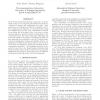Free Online Productivity Tools
i2Speak
i2Symbol
i2OCR
iTex2Img
iWeb2Print
iWeb2Shot
i2Type
iPdf2Split
iPdf2Merge
i2Bopomofo
i2Arabic
i2Style
i2Image
i2PDF
iLatex2Rtf
Sci2ools
ICIP
2000
IEEE
2000
IEEE
Model-Aided Coding: Using 3-D Scene Models in Motion-Compensated Video Coding
We show that traditional waveform-coding and 3-D modelbased coding are not competing alternatives but should be combined to support and complement each other. Both approaches are combined such that the generality of waveform coding and the efficiency of 3-D model-based coding are available where needed. The combination is achieved by providing the block-based video coder with a second reference frame for prediction which is synthesized by the model-based coder. Since the coding gain of this approach is directly related to the quality of the synthetic frame, we have extended the model-aided coder [1] to exploit knowledge about illumination changes and multiple objects. Remaining model failures and objects that are not known at the decoder are handled by standard block-based motioncompensated prediction. A Lagrangian approach is employed to control the coder. Experimental results show that bit-rate savings of about 35 % are achieved at equal average PSNR when comparing the model-aided c...
| Added | 31 Jul 2010 |
| Updated | 31 Jul 2010 |
| Type | Conference |
| Year | 2000 |
| Where | ICIP |
| Authors | Peter Eisert, Thomas Wiegand, Bernd Girod |
Comments (0)

